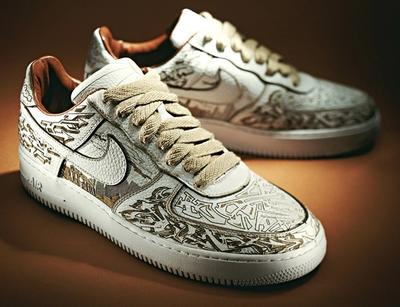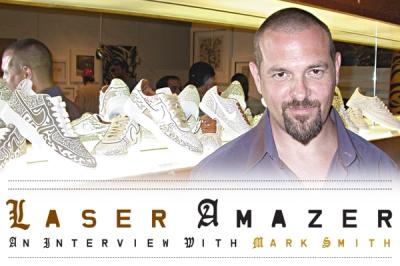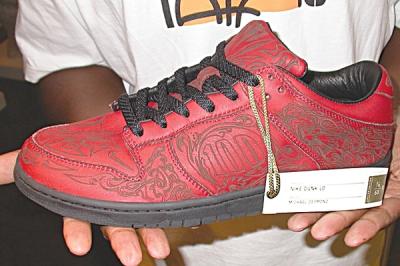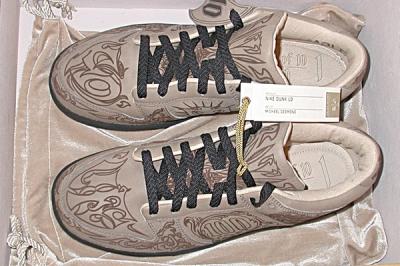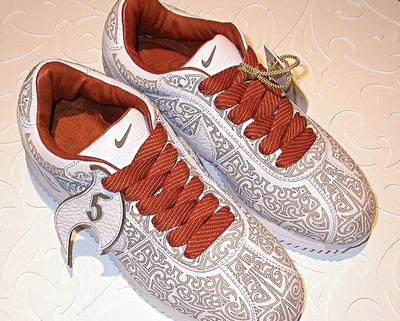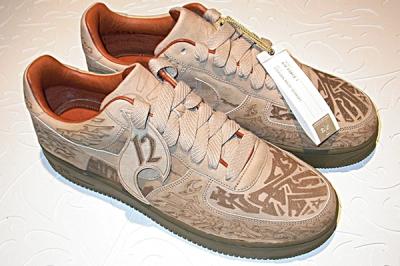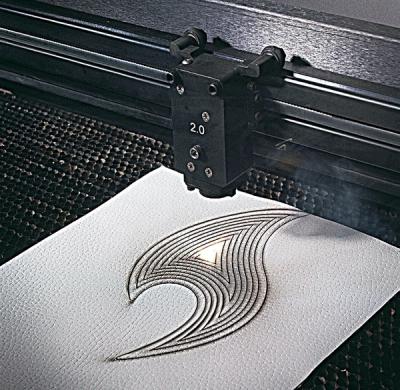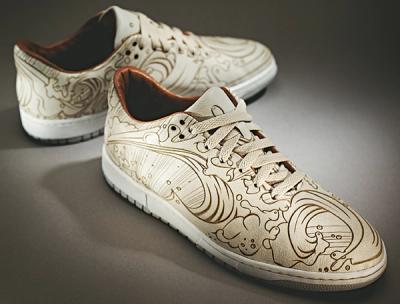Nike Laser - Interview With Mark Smith
With all our obsessiveness about shoes, it’s easy to forget that behind every great sneaker is a creative person struggling with inspiration. With that in mind, meet Mark Smith, curator of the Laser Project. How does the laser part work? Simply put, the beam of light follows instructions from a computer program to burn the leather in insanely intricate patterns - we’re talking about fractions of millimetres here! If it sounds hi-tech, it is. If it sounds space age, it isn’t. Laser technology is used in many everyday applications, from eye surgery to signwriting. As in music, where the spaces between the notes are the most important, the genius of the Laser project is not what is burned away, but rather what is left. We were part of a select bunch of players granted access to the Elizabeth Gallery in New York to hear Mark take us through the project step-by-step. Afterwards I spoke to him about his work...
Hey Mark, how did you come to be working at Nike?
Well, I have a degree in Advertising. With a minor in Psychology, I thought I’d be an ad guy back in the ‘80s. Then I earned a degree in Graphics/Packaging from Art Center College of Design. After graduation, I designed tees at Maui and Sons Surf in California. Then a bunch of friends moved to Oregon and started work at Nike. I figured if they could… (also my future wife was one of them, so, naturally, I followed). I was hired by Mark Parker and ended up in apparel until Tinker Hatfield hired me into footwear.
Shoe design seems to be bit of a glamour occupation at the moment, you guys are like rockstars! Kids are dreaming of designing Jordans rather than becoming firemen these days....
Yeah! Except rockstars get those funny colored M&Ms…
What other projects have you worked on at Nike?
Most of my work has been on concept stuff that never sees the light of day. Special projects and promos for specific athletes. I collaborated with Tinker on Jordans IX thru XV. Air Raid, Jordan Vindicate, Jordan Ultralite, those were mine. This year I did shoes for LeBron and a pair for Kobe. Most recently, I’ve been working on HTM, SWO and University of Oregon football uniforms. Tinker and
I have also begun work on the Air Jordan XX. I really never know from one week to the next what projects are coming down the road for me. That’s one of the best aspects of this place.
The most obvious reference is tattooing, are you deep into that?
I love the commitment it takes to permanently mark oneself. It also feels good and I enjoy the cultural significance. I like any true story telling that goes on in many personally designed pieces. It’s just a fascinating medium to work in - skin is a truly special canvas.
Laser technology has a wide-ranging series of applications, how did the Nike experiment with shoes originate?
Jay Meschter in the innovation kitchen was investigating the use of laser cutting on some very cool concept shoes. He was looking into some very interesting ways of slicing materials. I just saw another way of using this tool.
So, did you just call up Phil and ask for a laser machine?
Well, kinda… our group is tasked with innovation on many levels. We are fortunate enough to have access to tools that allow us to look into future applications and processes. Along that road, the laser became a natural tool for us to look into.
So, how does the process work?
We start with the flat pattern pieces. Design the graphic around the architecture of the shoe and its parts, and watch the tiny little sun burn its way into your retina for a while. Then we stitch them together. There are some slight differences between the samples made here in Beaverton and the factory built pairs. We consider the Beaverton pairs to be artists’ proofs, where we are working out the technical specifics. Each pair is unique, and has slightly different characteristics from which we pull certain details, compile them into the ‘best of’ and send to the factory to complete the process into a full run. The laser we are using is an R&D machine, a little bit different than the factory machines. We are learning every step of the way on this one because this is the first time for us.
I really dug your talk introducing your shoes at the exhibition.
Thanks. It was a lot of fun to tell the story of this project. It was the first time meeting most of the people in the room. Everyone was really cool and I had some wonderful conversations with people from all around the world.
Giving a pair to Michael for his 40th birthday must have been an occasion and a half. Were you nervous shipping them out?
The fact that they were the first round of that particular pattern and process meant that we had to be on our toes all the way through. Chanmy is an expert stitcher, and she really made the difference on the craftsmanship. I had a lot of help on the pattern work from Mike Friton in the kitchen, as well. A real team effort. It was a lot of fun hitting the deadline and coming through… We had about 4 days to actually pull it off.
Did he send you any feedback?
Yeah, he was very positive about them, and in turn he very kindly reciprocated for my 40th birthday. He also asked me to design him a motorcycle racing suit, based on the design cues from the shoes. He is on the track and very serious about the speed. Very serious.
Nice work bringing your mates in to the game! Tell us about them as individuals and why you chose them for this project?
I first asked Mike Desmond to play around with some pattern pieces as a canvas. I was introduced to Mike by a mutual friend, Aaron Cooper and we immediately struck up a deep friendship. He has a dual life, something I can relate to personally. Mike directs a concept car design crew for a major auto manufacturer during the day and he does hot rods with his brothers, and custom motorcycle stuff with
Jesse James at nite. Custom culture is in his blood.
I met Chris Lundy on the first day at Art Center. We were in the back of class leering at everyone, and I knew we’d get along. Chris was into big wave surfing on the north shore of Oahu. He had completely blown his knee in a serious accident. After rehab he turned his life over to painting. Flow is at the root of all his endeavours. Surfing, painting, boarding, guitar, and creative dialogue through the English language.
Tom Luedecke came to the innovation kitchen in February and I asked him to tap into his heritage as a German. With a keen eye for detail and a wonderful graphic sense, he dropped the Celtic bomb on the Cortez. Tom paints at night and has a serious background in the martial arts. His sense of humour was key to his success in interviewing for his position at Nike.
Around May, I called Maze to help out on the Air Force One. I had met him on a completely different project with Nike and immediately connected with his approach to creativity, humour and overall exuberance. He has an infectious laugh and has done everything from movie set design to directing and graphics. He is a bit of a legend in the graffiti world as well. And he’s a hell of a drummer. I knew that when I asked them to become involved, they would give way more than I could expect. It wasn’t about finding the biggest names and blowing this thing out. it was all about doing something very personal with some very personal friends.
Congratulations on a major breakthrough. I’m thinking not so much about the decorative aspect but the way you can sculpt leather. You showed me an Air Force One made out of one piece of leather!
Thanks very much. The one piece upper was a direct result of looking for the largest canvas available within the particular shoe pattern. This tool allowed us to explore this aspect fully. It also led to re-engineering the inside of the shoe completely from a pattern standpoint. I have to say it is fun seeing the moment when people see how the one piece construction was achieved.
You also told me to wear mine with no socks! Sounds dangerous...
I selfishly wanted the inside of the shoes to be as comfortable as possible because I rarely wear socks myself. The pigskin feels better than cotton or lycra. I wore a pair for 60 days straight with no socks and was actually able to remove them, in public, within a confined space, without incident or injury…
Is it just comfort or is there a performance aspect to this concept?
Comfort is key to performance.
Tell us about some of the performance applications you envisage? Will we see laser used in running or soccer boots for example?
We’re trying a lot of things with the laser.
You guys never give anything away! The laser product rolls out over the next few months - can you fill us in on the range? Some kids are gonna want the whole set!
There are 6 designs. We used the Air Force One, Cortez, and Dunk as platforms. Maze’s AF1 is standard construction with overlays. My AF1 is a one piece construction, as is Lundy’s dunk. Desmond’s Dunk is normal construction. Luedecke’s Cortez is one piece and my Cortez is normal construction. There will be 3 colorways. Pigskin linings, and slow recovery, collar foam packages. Plush Poron, pigskin covered sockliners. And the packaging is pretty sweet. We just wanted to keep them special so there won’t be millions of these floating around the world.
Thanks for your time Mark, good luck with your laser beam...
No, thankyou!
